October 28, 2016
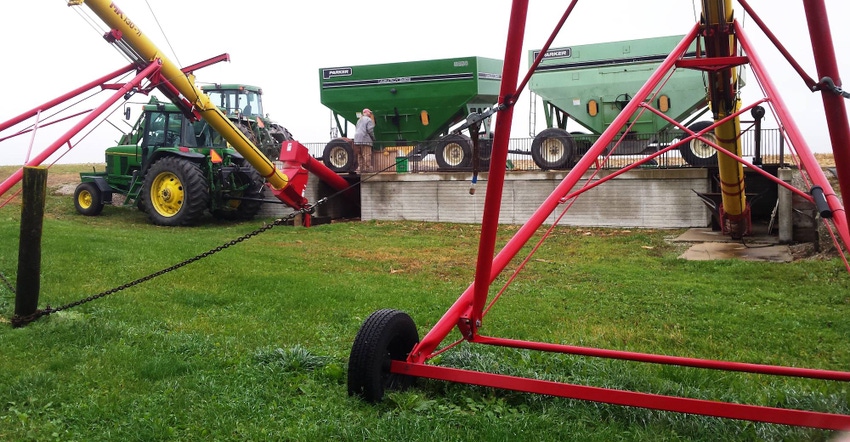
As the saying goes, "For every task, there is a tool." Almost any guy will tell you that there is no such thing as having too many tools. If you never know exactly what kind of task you may find yourself doing, you clearly cannot have too many tools.
The 2016 growing season has been one for the record books in my corner of the world. Seriously, we set some all-time records for precipitation. There was this tidbit from the National Weather Service a few weeks ago.
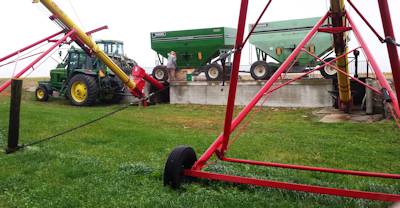
The grain setup, or rather the scene of the crime for Guy No. 2
We had been busy with corn harvest non-stop for almost two weeks recently with only .02" of rain one day in that period. Three days without precipitation was a rarity this year. The corn was drying down decently and we were making good time.
I was unloading wagons of corn at our bin site. We have eight, 500-bushel wagons hooked together in four pairs. Each pair has a speed hitch on it to enable us to hook and unhook the wagons from the tractor cab. They are a huge plus in time savings. Guy No. 1 hates to see anyone with two spare seconds on their hands, so he prefers to have someone follow him in the combine with a grain cart. That is usually Woody's job. I take wagons to and from the field when I'm not hauling dry corn somewhere with the semi.
We had a forecast for heavy rain coming later that night, so we decided to take things up a notch and get as much harvested in a day as we could. One particular variety of corn was dry enough to go straight into a storage bin without having to be dried. We set up an auger to the bin and made fairly short work of it. Then we switched back to putting the wet corn into the regular hopper-bottom holding bin to feed the dryer.
I pulled up with a set of wagons toward the end of the day. The crank on the door of the wagon didn't raise it like it normally does. If I could just get some leverage under the door, I figured it would work. A pry bar would be the perfect tool.

A carnival tool in a handy location
Oh, look! There's a pry bar hanging on a gate nearby. Gee, you'd think this very situation had happened to someone else in the last 24 hours and they went the same route I was about to try. That pry bar was hanging on the gate / fence we have between the elevated driveway where the wagons are and the tractor that runs the auger next to it. We put the fence in to keep any of us safe from falling off the platform when we turn on the tractor PTO. I had to walk past the gate several times for each set of wagons and I hadn't seen the pry bar before. It was a pleasant coincidence to have it there now.
My first job was to turn on the tractor PTO to power the 13-inch-diameter auger to move the wet corn to the holding bin. My next task was to open the wagon door and get some corn into that hungry beast of an auger. That pry bar just might make this task easier.
It did, but only for a second or so. That's when it slipped out of my hand and promptly fell directly between the steel grate of the unloading pit into the auger below.
You can move a lot of corn in short order with a 13-inch auger. You can move a lot of soybeans with one, too. You could even move a lot of oats with an auger like that. In fact, you can fill a semi in about six minutes with one.
No one moves pry bars with a 13-inch auger, though! Not a bunch of them, not a few of them, and especially not just one of them, and not in a hurry.
It looked to me like I was about to hear a really, really loud grinding noise. That's when I decided to rush to the PTO lever on the tractor and hope I could get it shut off before our corn movement was done for the night and I had to explain to GN1 just how I put the kibosh on progress right before the weather did.
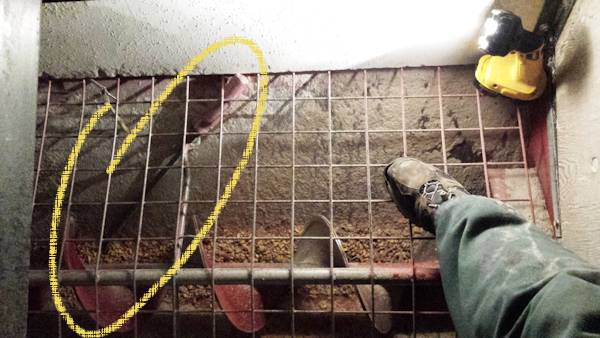
One prybar, one auger, and a little luck. But of course the prybar must be removed.
Fate was with me. The PTO was turned off without any special sound effects coming from the auger. I grabbed a flashlight, took a deep breath and peered into the pit below the grate. Resting at an angle, just above the auger flighting, was my pry bar. It was precariously perched atop one of the support rods that the safety cage is welded to above the flighting. That's what lets the corn through, but keeps the hands and feet out.
Not so bad, I figured. We had designed the system years ago where we could drive up an elevated driveway onto a concrete slab with two openings for augers. The corn falls into the pit and goes into an auger to be transferred to the two holding bins. All I had to was walk down to the lower level, reach in underneath the grate and see if I can get to the pry bar.
One of the first modifications we did to the new system was to put some plywood in the pit to keep corn from splashing out on the concrete where it would be rained on and spoiled, or it would be eaten by vermin. The plywood stood vertically and kept the corn in and the vermin and weather out. It also kept me out, because it was fastened very securely.
This was decision-tree time for me.
Question 1: Do I want to get chewed out?
Yes? Call GN1 and tell him what I had done.
No? Work on it myself, and maybe keep it to myself.
Question 2: Would a tool help?
Yes? You're a guy. Of course a tool would help! No isn't even an option. Next question.
Question 3: Would a magnet help?
No? Go inside and watch a Lifetime movie of some kind . . . in your pink bunny slippers.
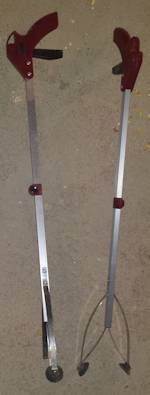
Hoping this is the right tool for the job...it's not.
Yes? Magnets are science. Guys love science. Of course a magnet will help! Get a couple of magnets and try it. First, try a golf club-style magnet. When you discover it's the wrong angle to fit between the steel grate of the drive-over pit, try a squeegee-style magnet. When you find it's too wide, move to the next question.
Question 4: What would Wile E Coyote, Bugs Bunny and/or Red Green do?
They would use the right tool. There's your answer. Carny it up! Go with a reachin' stick! It would be just like the claw game at the fair where you try to reach into a pile of stuff with a crane hook, grab your bounty and walk away smiling.
As it turns out, The Chairman Emeritus happens to have a reachin' stick. I believe he uses it for retrieving walnuts from the ground so that he can gather them like a squirrel and then shell them out over the winter to routinely add to his ice cream sundae.
A quick trip to the house revealed that there did happen to be not one, but two reachin' sticks in the garage. I was maybe a little vague as to why exactly I needed them at the moment. The last thing I needed was an even bigger audience telling me what I was doing wrong and how it shouldn't have happened in the first place.
My reachin' sticks and I made our way to the crime scene. I quickly discovered that the angle of my pry bar and the grabbing ability of my two reachin' sticks were such that I couldn't make any progress. I was back to the trunk of the decision tree: Do I want to make the call to GN1 and admit defeat, or do I want to keep this on the down-low until I figure it out myself?
GN1 was about a mile away. Rain was maybe 30 miles away. Both of them could be unsettled upon their arrival.
I decided to try something different. I remembered using the skid loader and chains to put the steel grates over the pit in the past. It worked fairly well, but it worked much better when a couple more sets of hands were there to turn the suspended grates and line them up where they needed to go. Perhaps I'd try it solo and see where it would get me.
The skid loader was brought to the crime scene. I only had one chain with me, and it was a safety chain with a cool loop on one end. That makes it easier to cinch up against the target cargo without having the chain come unhooked.
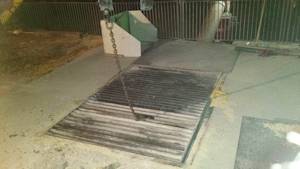
Using a chain and a skid-steer, to reach that prybar.
I took the pallet forks of the skid loader and lifted the steel plate off the grate. The plate covers one end of the pit to ensure that the corn hits the auger hopper and doesn't splash around. Two-by-fours had been added to the underside to make sure the plate stayed in position (and to make it more of a carnival game for me to line up perfectly when I rearranged everything later.)
The chain was hooked to the steel grate and I proceeded to lift it gingerly with the skid loader. It came out quite nicely. I set it to the side and found myself a very easy access point to the auger hopper below. It took a little bit of finagling to get the pry bar out without dropping it into the bottom of the hopper, but I managed to get it done. The pry bar was then set about ten feet away to keep me from knocking it back in the hopper when I did the whole procedure in reverse next. (I know my skills and tendencies.)
That's when the carnival aspect returned. One chain worked really slick to get the grate out of its normal position. Putting it back in was a different story. I was back to operating that carnival crane in pursuit of a prize. A second chain would have helped, but a second and third set of hands would have helped more. Two to four more hands would have steadied and shifted the now-swinging grate into position with no problem. This wasn't exactly delicate brain surgery, but I felt a little bit like that gorilla in the American Tourister ad years ago. I needed to gently set my luggage down, but it felt like I was flailing it around with reckless abandon like that gorilla.
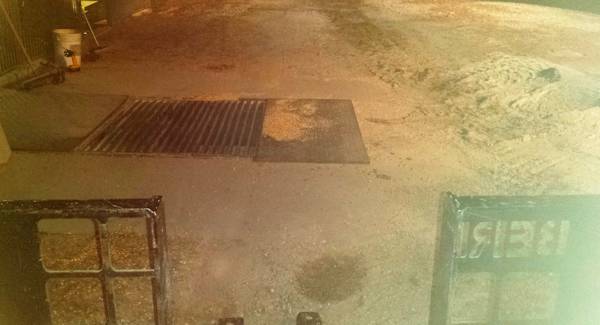
When the work is done, evidence must be removed, like those footprints and skid-steer marks.
My carnival crane skills finally got sharpened enough that the grate lined up in position. It was back where it should be. I made sure the plywood was in position and then I set the steel plate back in its rightful spot. You would never have known that such stupidity even happened.
Well, except for all of the skid loader tracks where I had been playing crane operator with a lot of side-to-side motion for the last half hour or so. A quick brush with my foot and a broom pretty much removed any of the evidence that existed.
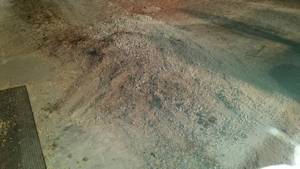
Evidence removed, now
A new term was invented. Moron-proofed. The definition of foolproof is "incapable of going wrong or being misused." That is an adjective. My term is moron-proofed. It's a verb, meaning "To remove any physical evidence that a moron did something at this particular location."
There was one last hurdle. Even though I felt I put everything back together like it should be, I wouldn't really know for sure until I drove over the pit. Sure, I could hook onto a pair of wagons and try that, but let's assume for a minute that not everything was done up to code. If something ends up falling in the pit due to my ongoing error, I'd prefer it to be the little skid loader (that I rarely use) instead of a big tractor and/or some wagons.
The post-reconstruction maiden voyage was uneventful. I drove across the grate in the skid loader with no problem. There was no creaking, no grinding and no clouds of dust, ala Wile E Coyote.
The wagons were brought up to the pit. I opened the door with the pry bar and had a death grip on it the whole time. Partway through the first load, my phone rang. It had been dead silent for an hour or so during my whole episode, which surprised me. Guy Number 1 was calling.
"What are you up to?" he inquired.
"I'm in the middle of unloading the last set of wagons that are going to fit in the hopper bin. Should have them out to you in a few minutes," I said, leaving the last hour or so a complete mystery.
Nothing to see here, folks. Go back to your homes. We will not be taking any further questions at this time.
Guy No. 2
About the Author(s)
You May Also Like






